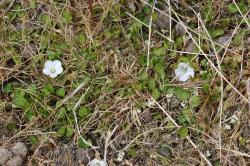- Taxon
- Gallery
- ≡ Convolvulus verecundus subsp. waitaha Sykes in Connor & Edgar, New Zealand J. Bot. 25: 154 (1987)
Low-growing perennial herb, with creeping rhizomatous stems, short ascending to spreading branches, and lianoid stems up to 80 cm; lianoid stems with a sparse to moderate covering of retrorse hairs. Leaves in rosettes and alternate on stems, 6–17 × 5–12 mm, deltoid, deltoid-ovate, broad-oblong, green; glabrous or with a few scattered hairs near junction of lamina and petiole; veins immersed on adaxial surface; margin entire to undulate, irregularly lobed; base truncate, sometimes oblique; apex usually retuse, occasionally obtuse to subacute; petiole channelled, sparsely to moderately covered with retrorse and antrorse hairs. Pedicel 8–18 mm long, 0.6–1.3 mm diam., sparsely to moderately hairy. Sepals 3.6–4.0 × 2.1–2.6 mm, obovate to ovate, green; abaxial and adaxial surfaces glabrous; margin fimbriate and translucent; apex subacute to obtuse. Corolla 7–13 mm long in bud, 10–16 mm wide when open, white, five lobes fused for > 3⁄4 of their length; lobe apex fringed with hairs; tube 4–6 mm long, pale green; abaxial surface with mid-petaline green bands with sparse appressed hairs on upper third. Nectary annular, 0.3–0.4 mm tall, yellow. Style 2-cleft, white; fused portion1.6–3.0 mm long, 0.4–0.5 mm wide; stigmata 1.0– 2.5 × c. 0.5 mm. Ovary c. 1.0 × c. 1.0 mm, cream. Filaments 1.7–3.0 mm long, c. 0.5 mm wide at base, tapering to 0.2 mm at apex, white; margin with scattered short hairs on lower half; fused to base of corolla tube. Anthers 1.7–2.0 mm long, white. Capsule 5–6 mm long, 5.0–6.5 mm wide, chartaceous, globose, with 2–4 seeds, lower half enclosed in persistent calyx, style base remnant persistent. Seeds segment-shaped or hemispherical, broader toward apex, with a broadly rounded dorsal surface and usually two flattened or concave lateral faces meeting at a rounded or flattened ventral ridge, sometimes with a single flattened ventral surface, almost triangular in section; 3.1–3.9 × 2.3–3.3 mm; apex and base rounded; hilum concave. Testa brown and ornamented, grey nut-brown, dull, glabrous, densely covered in distinct irregular tubercles and ridges, these often narrow and forming broken ridges along margins of faces. FL Oct–Feb; FT Dec–Mar.
[Reproduced from Heenan et al. (2003, New Zealand J. Bot. 41: 447-457) with permission from The Royal Society of New Zealand.]




